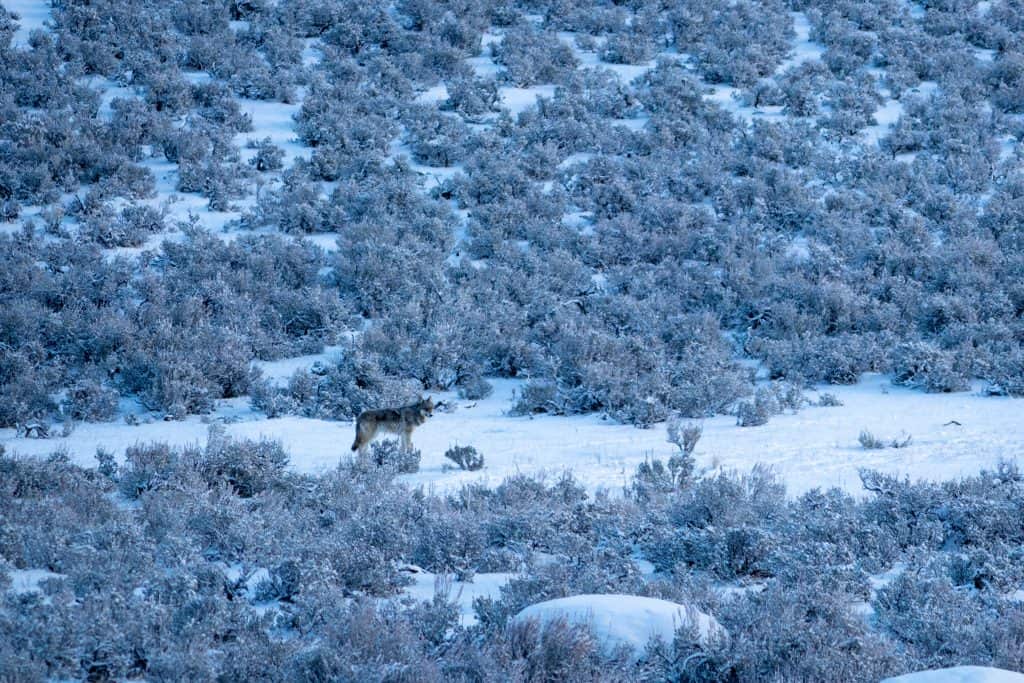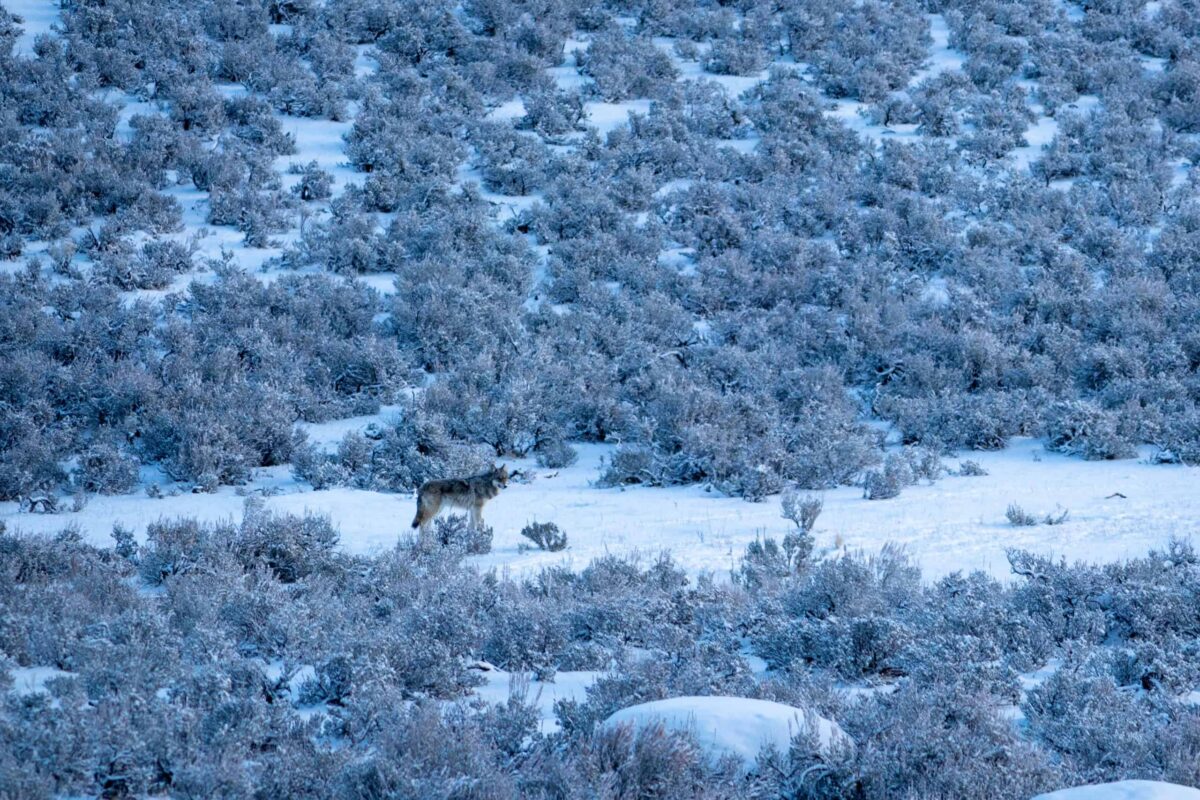By Courtney King

Last month, the community in and around the Gunnison Basin were invited to one of a series of meetings surrounding the process of wolf reintroduction in Colorado, which was mandated by a 2020 ballot measure. Perhaps the largest draw to the well-attended Gunnison forum back on Jan. 25 was the opportunity for the public to weigh in with two-minute comments.
In a sentiment reminiscent of a statement made by rancher and far-right extremist militant Ammon Bundy (“if force is used against us, we would defend ourselves”), one member of the ranching community utilized their brief moments to declare that agricultural producers would flock together if their responsibility to produce food for the community was obstructed.
The meeting proved fairly tame otherwise, and a few main sentiments were reiterated by much of the public and the CPW Commission itself. Attendees couldn’t go very long without hearing one common theme reiterated: money, or lack thereof. Specifically, who is to pay when there are financial losses attributed to wolves.
Indeed, one of the day’s few outbursts was an attendee blurting out “we can’t afford that,” in response to a Commission member’s comment about a voluntary insurance program for wolf depredation, which has been attempted in other western states.
In short order, CPW will be responsible for introducing and subsequently managing wolves, using much of their staff and resources otherwise dedicated towards other species (non-hunted species, that is, as the funds generated from hunting and fishing are not fair game for usage on wolf reintroduction).
They’ll also have to shoulder the blame — rhetorically and financially, for human-wolf conflict, which will most likely take the form of livestock kills.
The agency’s draft plan even outright states that CPW lacks the staffing and financial resources to undertake the lengthy, and costly, National Environmental Policy Act (NEPA) compliance that would be required to release wolves on federal land, so the 30 to 50 wolves to be released beginning in 2024 will instead be released on state land — and private land with the permission of landowners.
The compensation conundrum
There remain uncertainties within the ranching community about the lost livestock policy – and whether it truly counts as fair compensation. To start off, there are instances where proving a livestock fatality is impossible — with calves who have just been born and are not yet tagged, for example.
Then there’s the compensation ratio, where ranchers can claim compensation for up to five cattle or sheep if at least one depredation is confirmed and other, additional animals are lost (and up to seven cattle or sheep if they’ve used mitigation strategies, but more on that below).
Other western states utilize compensation ratios to account for the fact that some wildlife experts and state officials believe the bulk of wolf kills are either never found, or cannot be confirmed as a wolf kill,
Matt Barnes, a former rancher and conservationist who sat on the state’s Stakeholder Advisory Group (SAG), which contributed ideas that helped formulate the draft plan, says that in Wyoming — where compensation ratios were utilized in certain circumstances — one rancher said he liked compensation ratios because it allowed him to cash in for sick calves, which were worth more dead than alive.
That incentive is part of why Barnes opposed the idea of utilizing compensation ratios in Colorado.
Across the board, answers cannot come soon enough for those concerned about wolves arriving in Colorado, either via natural migration or planned CPW release. Don Gittleson, a rancher north of Walden, has been the focus of much attention after five of his cattle were killed by wolves, half of the confirmed wolf depredations in Colorado over the past year.
A common argument raised by the ranching community is that if CPW resources are already strained, how are CPW officers going to be able to visit ranches to effectively confirm that missing or dead livestock were in fact killed by wolves?
While the agency “presumes causation once a confirmed depredation” occurs, ranchers worry about qualifying for payments if agency representatives must travel to visit the kill sites, which can be remote and require hours on dirt roads or via horseback to reach.
Another point of contention is the difference between confirmed kill and “presence” of wolves, with ranchers arguing that financial and other losses can occur even if no animal is killed. For example, livestock owners have mentioned that scared animals can run into fences or otherwise injure themselves, which would be an uncompensated loss.
Less directly, long-term stress can lead to reduced milk production and lower birth rates – although wolves would certainly not be the only source of stress for livestock, which can be upset by a variety of social, human, and environmental factors.
CPW’s draft plan proposes that ranchers receive up to $8,000 per every animal killed by a wolf — at fair market value. Livestock owners argue that sum does not always recoup their losses, if, for example, the particular animal lost is a product of decades of selective breeding.
The prospects for mitigation
Given all this concern over compensation, what CPW’s plan to minimize payouts for depredated animals? Thus far, their strategies in the draft plan call for “hazing” of wolves using non-lethal methods — strategies like using rubber bullets, flagging on electrified fences, flashing devices, and even “evil eye” ear tags.

In Washington state, mitigation strategies have included range-riders, sanitation programs (removing dead carcasses from ranch), specialized lighting, fencing and guard animals. Most of these strategies have been mentioned as having potential for use here in Gunnison.
Washington’s mitigation efforts are paid for through a voluntary cost-share program, which invites ranchers to participate before they have experienced wolf depredation, or other harms associated with wolf presence.
Here in Colorado, where wolf reintroduction came about via ballot measure, ranchers who voted against the proposition don’t believe they should have to pay any portion of the costs for something they didn’t want in the first place.
An academic study looking at Washington ranchers’ perspectives around wolf reintroduction and non-lethal control found that, at the end of 2017, only 37 out of more than 8,000 livestock producers had signed an agreement to enroll in the cost-sharing program. In declining to participate in the program, ranchers often cited their disdain for what they view as government overreach and excessive regulation.
They also frequently mentioned a fear of wolves and the damage they could cause – directly, but also more existentially, on their way of life. The presence of wolves can make it harder, for example, for younger ranchers to begin their own ranching business — or continue their family’s.
The researchers found, unsurprisingly, that “ranchers with large operations and who had been ranching for multiple generations and were dependent on ranching as their only source of income were least willing to participate in mitigation measures.”
A web page from CSU’s Center for Human-Carnivore Coexistence notes, “although wolf depredation on cattle and sheep accounts for less than 1% of the annual gross income from industry-wide livestock operations in the Northern Rocky Mountains, these costs are unevenly distributed and localized, with some producers suffering greater losses than others.”
For ranchers, who believe the government is willfully exposing them to potential risks and property damages they otherwise would not (and should not) have to reckon with — why would they trust the government to adequately respond if such damages did occur?
In Wyoming, ranchers have appreciated management efforts being turned over from the federal government to the state, where they believe their interests are more accurately represented. Many ranchers in the state have said that compensation payouts for livestock losses are a major factor keeping them in business.
It’s important to note that not all ranchers are against wolf reintroduction, however, and even those who are would nevertheless be wise to explore strategies to prevent or minimize depredation within their property boundaries.
One particularly interesting form of mitigation is to use husbandry practices that may reduce the risk of depredation while offering a series of other benefits.
Rotational grazing is a practice commonly cited as a method to retain and improve the health of the soil — aiding crops, but also the livestock that graze upon them,
In practice, the method keeps livestock in smaller areas, allowing (and requiring) ranchers to monitor them more frequently. Such increased vigilance not only makes it more likely that ranchers would notice a missing or killed animal, but also that they would notice and be able to respond to a sick or injured animal who might prove more vulnerable to wolf attack.
Spending more time out on the pasture, or hiring someone to do so, might seem infeasible for many ranchers in the Centennial State. Elsewhere, ranchers have explored interesting possibilities, however, such as hosting farm tours and allowing hunters and horseback riders access to their properties. Not only do such activities bring more human presence, they can also generate extra income.
What remains unclear is how much material support CPW is willing to provide for such mitigation strategies, and which of these tactics may qualify for state funding. It’s also unknown whether the state will receive additional funding, or rope in another entity, like the U.S. Fish and Wildlife Service, to help foot the bill.
Notably, ranchers who deploy mitigation strategies will be eligible for higher compensation rates, although some fear this will simply turn into wasted time and resources for the sake of box-checking.
Many ranchers want to know if and when they may take matters into their own hands — legally killing wolves themselves, or, at the very least, getting the state involved to remove known problem wolves.
How “problem wolves” would be dealt with in Colorado has remained largely unclear, with questions surrounding legal take given the (lack-of-an) answer: “stay tuned.”
Ranchers and recreationists alike are certainly interested in hunting wolves, and there is a mechanism by which that would be allowed if the species reaches high enough numbers to be delisted at the state level and attain classification as a game species.
As a prospective solution for depredation, lethal control may not be as direct of a solution as many assume it to be. A study in Germany (where human-wolf conflicts have recently been escalating) found that lethal control and translocation were less effective at preventing damage to livestock compared to methods like deterrents, fencing, herding, and calving control (synchronizing birth rhythms, thereby keeping a close eye on calves when they are most vulnerable).
Lethal removal has even been cited as playing a role in increasing conflicts, or leading wolves to depredate livestock on neighboring properties.
Regardless, it’s clear Colorado Parks and Wildlife expects individuals to follow through on their promises that they “take matters into their own hands.”
On their website, CPW outlines the penalties for killing a wolf on a frequently asked questions (FAQ) page, stating “we strongly encourage people to be ethical and follow the law.”
In reality, that likely won’t happen until ranchers feel their concerns are heard and being adequately addressed.
In the meantime, CPW has several months to finesse its plan to ensure that stakeholders are up to the task of wolf reintroduction.
The upcoming wolf reintroduction plan timeline can be found below:
- April 6: Colorado Parks and Wildlife set to present final plan to Colorado Parks and Wildlife (CPW) Commission
- May 3 and 4: Commission set to take final vote on the reintroduction plan
More info on the meetings can also be found on CPW’s website.

